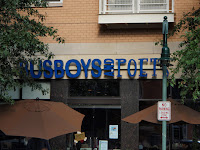 Here in the DC area, in early November, we still have some delicious Fall weather. The leaves are turning or have turned, and it is still warm enough to walk around without bundling up.
Here in the DC area, in early November, we still have some delicious Fall weather. The leaves are turning or have turned, and it is still warm enough to walk around without bundling up.I decided to savor this climate, which we all know can turn on a dime, to enjoy Dumbarton Oaks public park, garden, and museum.
The public park
The official Dumbarton Oaks grounds only open at 2 PM in the winter (which starts November 1), but is free in the "winter season" which is a savings over the high season cost of admission ($8/ adult, $5 for each child and senior citizen). I arrived early, so I began my tour of Dumbarton by going for a walk in the park literally next to the Dumbarton Oak grounds. The park has an informal dog run, and paths where local families took their kids for a picnic, and some just went for a joyous Fall afternoon. The public park is very natural and beautiful, with a small stream that is evidently popular with children. There is no public rest room. Dumbarton Oak garden
 In the Fall season, the Dumbarton Oaks grounds are not crowded, which is nice for everybody. Parents let their children run loose without worrying they would bother other guests, and everyone got a sense of having the grounds somewhat to themselves. The grounds are large, which you get a hint of by the large front yard leading up to the house. They include terraces, a rose garden, fountains, and sculptures. Parents might want to note that there is only one bathroom stall available for public use in the green house.
In the Fall season, the Dumbarton Oaks grounds are not crowded, which is nice for everybody. Parents let their children run loose without worrying they would bother other guests, and everyone got a sense of having the grounds somewhat to themselves. The grounds are large, which you get a hint of by the large front yard leading up to the house. They include terraces, a rose garden, fountains, and sculptures. Parents might want to note that there is only one bathroom stall available for public use in the green house.Dumbarton Oak museum
 The house itself is closed to the public, but around the corner is a museum entrance, which the last private owner of Dumbarton Oaks is individually responsible for. The last private owner, Mr. Robert Woods Bliss collected Byzantine and pre-Columbian art, including armor, gold pieces, and ceramics, while he owned the grounds. He also created an enormous music room which earns the envy of any present-day entertainer. The music room has 15th and 16th century furniture and a mural dated 1928 in a back alcove. On the right upon entering, it has a beautiful old piano. The basement has public restroom for visitors -- I recommend these restrooms to parents who are spending the afternoon at Dumbarton! But remember, it only opens at 2 PM.
The house itself is closed to the public, but around the corner is a museum entrance, which the last private owner of Dumbarton Oaks is individually responsible for. The last private owner, Mr. Robert Woods Bliss collected Byzantine and pre-Columbian art, including armor, gold pieces, and ceramics, while he owned the grounds. He also created an enormous music room which earns the envy of any present-day entertainer. The music room has 15th and 16th century furniture and a mural dated 1928 in a back alcove. On the right upon entering, it has a beautiful old piano. The basement has public restroom for visitors -- I recommend these restrooms to parents who are spending the afternoon at Dumbarton! But remember, it only opens at 2 PM.Bonus Information
Like many of the large and beautiful homes of earlier times, the grounds were used for historical events. Dumbarton Oaks hosted the "1944 Conversations", a meeting of American, British, Russian, and Chinese diplomats and statesmen who met to discuss and negotiate for international peace, friendly relations, international cooperation, and reaching common ends. Dumbarton Oaks has a relaxed outdoor element to it, as well as educational elements. It is up to the guest what he or she gets out of it. I will tease you with one fact though -- the house started with the Rock of Dumbarton in 1702!













































